Archaeologists unearth mummy conserved through peculiar anal embalming technique
In a fascinating discovery, archaeologists have unearthed the well-preserved mummy of a 280-year-old Austrian priest named Franz Xaver Sidler von Rosenegg. The mummy, found in the crypt of St Thomas am Blasenstein, has left researchers puzzled due to its unusual mummification method.
The mummification process involved stuffing the rectum with wood chips, twigs, fabric, and a substance containing zinc chloride. This method, which appears to be unique, has not been previously documented by archaeologists. The embalming materials extracted from the mummy's body included fir and spruce chips, twigs, and fabric made from linen, hemp, and flax.
To confirm the identity of the mummy, extensive analyses were conducted using computed tomography scans, radiocarbon dating, and chemical analysis. These tests revealed that Sidler died between 1734 and 1780, aged 35 to 45. Toxicological analysis also confirmed the use of zinc chloride inside the mummy's body.
A small glass bead was found inside the mummy, possibly lost during embalming. The mummy's upper body is almost completely intact, while his head and lower body show considerable decay. The analyses also provided clues about the priest's diet, lifestyle, and health.
The reason for Sidler's unusual mummification method remains unclear. While some written evidence suggests that cadavers were prepared for transportation or elongated laying-out of the dead, no precise descriptions are available. It is possible that Sidler was intended for transportation to his home abbey, which may have failed for unknown reasons.
The extent to which rectal embalming was practiced in the past is still unknown to archaeologists. Rectal embalming might have been more common than previously thought, as less well-preserved bodies may have gone unnoticed. The search results provided do not contain specific information about the origin, prevalence, or purpose of this unique mummification method.
Historically, mummification practices in Europe were rare compared to ancient Egypt or South American cultures. However, some Austrian or Central European priests or nobles were embalmed using special church or local techniques involving drying, aromatic herbs, or wax to preserve bodies for religious or symbolic reasons. These methods were generally not widespread and served to honor the deceased, demonstrating piety or status, often linked to beliefs about the afterlife or saintliness.
This intriguing discovery promises to shed light on a previously unknown aspect of European mummification practices and is a significant addition to our understanding of the past. Further research is needed to uncover the mystery behind the unique mummification method of Franz Xaver Sidler von Rosenegg.
- The unique mummification method used on Franz Xaver Sidler von Rosenegg, with its use of zinc chloride and various materials like wood chips, twigs, and fabric, is a new entry in the field of scientific research on ancient embalming processes.
- The health and wellness of Franz Xaver Sidler during his life can offer insight into the medical-conditions and dietary practices of people during his time, as revealed by the analyses conducted on his mummy.
- The environmental science angle of this discovery includes the examination of the materials used in the embalming process, such as fir and spruce chips, linen, hemp, and flax, which could provide data on the availability and usage of these resources during the 18th century.
- The research on Franz Xaver Sidler von Rosenegg's mummification process may lead to a better understanding of historical practices related to fitness and exercise, as rectal embalming practiced in the past could potentially be linked to existing knowledge about anatomy and bodily functions.
- Mental health and skin care aspects could also be explored through this discovery, as the unique mummification method might offer insights into the concerns and beliefs about body preservation and the treatment of deceased during that period.
- Expanded research on neurological disorders could potentially benefit from the examination of Franz Xaver Sidler von Rosenegg's mummy, as the knowledge gained from the analyses conducted could shed light on the health and wellness practices of the past related to brain function and diseases.




